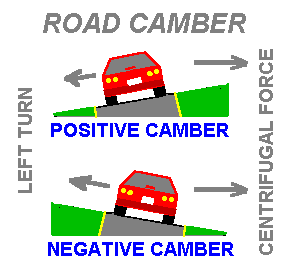CORNERS THAT KILL: HOW TO SPOT THEM BEFORE THEY BITE YOU
by John Lee

It is not always possible to be the best, but it is always possible to improve your own performance. --Jackie Stewart, Formula One World Champion
Another thing to watch out for: when it comes to corners, there are several dangerous types that can quickly catch a driver off guard, and perhaps lead to a deadly crash. These corners also exxagerate the flaws of front-wheel-drive. These defective roads are built by the government, who could at least install signs warning unsuspecting drivers of the specific danger (not merely a "curve" sign with a ridiculously low speed limit, which practically invites a driver to enter the curve too fast--all drivers have learned to ignore these silly things. Crying "wolf" is counter-productive to safety).
A "normal" corner has a steady curve to it, without any surprises. It is so easy to drive through it that a driver hardly even notices it.
However, there are six types of corners that can cause a driver to miscalculate a safe or comfortable speed through them, and lead to a situation requiring the driving techniques described above. Like a golfer who must learn how to "read" the surface of the golf course he is competing on, drivers must also constantly assess the roads they drive on.
- Downhill.
In this type of corner, the car will naturally try to pick up speed. Most drivers would respond by backing off the throttle pedal, which could possibly result in loss of steering control due to power-off understeer.
- Decreasing Radius.
This type of corner is very deceptive. The further the car goes into the corner, the more the steering wheel needs to be turned by the driver. This makes the driver uncomfortable. He realizes that he wants to slow down, so he takes his foot off the gas pedal. With a front wheel drive car, the result can be power-off understeer, and a loss of steering control. Many corners have several changes of radius, further challenging the driver. (Such corners make it impossible to stay in the center of the lane, leading a police officer to misinterpret a citzen's performance as "weaving.")
Remember the Friction Circle:
Reduce speed as turn gets tighter. |
- Off-Camber.
Camber is the "tilt" of the road surface. Most road corners are designed with a little bit of "banking" to assist cars by improving cornering force and traction. Positive camber (banking) allows centrifugal force to squeeze the tires into the asphalt. Like racing tracks, most freeways and their entrance and exit ramps are built this way. Negative camber ("off-camber") means the opposite; the corner actually tilts in a way that reduces cornering force and traction. Centrifugal force literally lifts the tires away from the ground (actually, it merely reduces to power of gravity to pull the tires into the asphalt). These corners are deceptive because they look faster than they really are. Once a driver gets half way through one, he might decide to try to slow down by backing off the throttle, resulting in power-off understeer.
Road camber affects tire grip. |
- Bombhole.
This corner feels like a crater left over from a bomb blast. These corners are named after Bombhole Corner at Snetterton racetrack in England, which was an American B-17 bomber base during World War II. Bombhole corners begin as either a normal camber or positive camber corner, with a sudden, unexpected shift to negative camber. Halfway through the corner, the bottom suddenly falls out. This unsettles both car and driver, and the tires' friction circle suddenly contracts to a mere fraction of its normal grip. It's like hitting a patch of oil or ice. When the driver attempts to slow down by taking his foot off the throttle pedal, power-off understeer can result. This is the type of corner that contributed to my friend getting seventy feet of guardrail pass through his body. These are illegal, defective turns, which violate government regulations for safe highway construction. Fortunately, this makes them rare. Unfortunately, they often catch drivers by surprise simply because drivers rarely encounter them. Sloppy driveway intersections on curvy rural roads are perhaps the most common example of bombhole curves, although they can occur anywhere.
- Blind.
A blind corner is one that has part of the corner obscured by a hill or trees, so that a driver cannot anticipate what to expect next. An unexpected surprise could lead to the driver attempting to slow down in the middle of the corner.
- Combination.
This corner is the most dangerous of all. A lot of things are happening at once. Once again, backing off the throttle, with a front wheel drive car, is going to result in power-off understeer, and a loss of steering control, the severity of which will depend on how far off the driver miscalculated his comfortable speed. As mentioned previously, "comfortable" is how the driver feels, not necessarily how well the car is capable of performing. By trusting in these driving techniques, and trusting in the cornering capability of the car, the best possible chance for safety will be returned back under the driver's control.
One final point on cornering. On an unfamiliar race track, a racing driver never drives at maximum speed. He has to take it slow until he has memorized every aspect of each corner. Often, he will take detailed written notes of each corner on the track, analyzing the different catagories listed above. Only after dozens of slow laps, gaining experience with each corner--and warming up his tires to the boiling point -- will he then attempt a high speed lap. After he has been away for a few days, or if the weather has changed, he will always take it slow again, until every corner is intimately familiar. Keep that in mind when driving on an unfamiliar road. There is no telling what to expect. Even if a driver has driven a road a hundred times, weather conditions could have affected it differently, and nighttime can always produce the unexpected, such as wild animals making their nightly rounds. Deer are the most deadly animal in America today -- hundreds of pounds of meat crashing through a glass windshield can ruin your whole day (a $10 investment in ultrasonic warning devices can save a life).
|























